Without the radar, the mission`s resolving power will be limited to regions of almost 40 km for soil moisture and freeze-thaw.
However, the mission will continue to produce high-quality science measurements supporting SMAP`s objectives with its radiometer instrument, the US space agency said in a statement.
"Although some of the planned applications of SMAP data will be impacted by the loss of the radar, the SMAP mission will continue to produce valuable science for important Earth system studies," said Dara Entekhabi, SMAP science team leader at the Massachusetts Institute of Technology (MIT) in Cambridge.
On July 7, SMAP`s radar stopped transmitting due to an anomaly involving the radar`s high-power amplifier (HPA).
The HPA is designed to boost the power level of the radar`s pulse to more than 500 watts, ensuring the energy scattered from the Earth`s surface can be accurately measured.
Following an unsuccessful attempt to power up the radar unit, the mission scientists have exhausted all identified possible options for recovering nominal operation of the HPA, concluding the radar is likely not recoverable.
The SMAP mission is designed to help scientists understand the links between Earth`s water, energy and carbon cycles and enhance our ability to monitor and predict natural hazards like floods and droughts.
SMAP remains an important data source to aid Earth system modelling and studies.
The data have additional practical applications, including improved weather forecasting and crop yield predictions.
The first data release of soil moisture products is expected in late September.
To date, the mission has collected more than four months of science data, almost three months with the radar operating.
More about:
















































